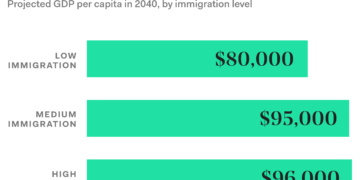[ad_1]
The Supreme Courtroom issued a 5-4 resolution on Could 16 rejecting federal court docket evaluate of fact-finding performed by immigration courts. The Courtroom’s reasoning may have wide-ranging impacts on many extra varieties of immigration reduction.
The case—Patel v. Garland—facilities round Pankajkumar Patel, a local of India, who erroneously checked a field on a Georgia drivers’ license software labeled “U.S. citizen.” Checking the field made no distinction at that second, as he was eligible for a drivers’ license even with out being a citizen. That mistake haunted him when he went to use for adjustment of standing after dwelling and dealing in the USA for 15 years.
The immigration court docket discovered Patel ineligible for reduction as a result of the federal government claimed Patel misrepresented that he was a U.S. citizen when he inadvertently checked the related field on an software for a Georgia drivers’ license. His attorneys argued that every one questions as to the eligibility for reduction ought to be reviewable as a result of the immigration statute solely prohibits evaluate of the final word discretionary resolution to grant reduction.
However Justice Amy Coney Barrett, writing for almost all, discovered that the immigration statute bars federal courts from reviewing questions on an individual’s eligibility to regulate their standing. On this case, there was a factual dispute about whether or not Patel deliberately marked “U.S. citizen” on his drivers’ license software to profit from that error.
“Federal courts have a really restricted function to play on this course of,” Barrett wrote. “With an exception for authorized and constitutional questions, Congress has barred judicial evaluate of the Lawyer Normal’s selections denying discretionary reduction from elimination.”
The bulk’s conclusion stems from the interpretation of the phrase “relating to reduction from elimination,” decoding “relating to” broadly to brush any and all determinations associated to reduction from elimination, together with whether or not somebody is eligible below the statute.
Immigration court docket proceedings typically have two phases: a elimination stage and a reduction stage. First, the court docket should decide if the immigrant is detachable. An individual can not ask for reduction till the court docket makes that dedication. On the reduction stage, a court docket should reply two questions: first, whether or not the noncitizen is eligible for reduction; and second, whether or not the court docket ought to grant that reduction in its discretion.
In an exasperated dissent, Justice Gorsuch, joined by the Courtroom’s three liberal justices, construed the textual content of the judicial evaluate statute, its context inside and amongst different immigration legal guidelines, and Congress’s legislative historical past to conclude that almost all was incorrect. Congress by no means supposed to bar judicial evaluate of questions of eligibility for reduction; it solely supposed to bar evaluate of the final word resolution to grant or deny reduction.
“At present’s interpretation seeks to cram a veritable legislative zoo into one clause of 1 subparagraph of 1 subsection of our Nation’s huge immigration legal guidelines,” wrote Gorsuch.
And apparent factual errors are sure to be made—with a case backlog of practically 1.8 million circumstances and an over-stressed and under-staffed court docket system, it’s no shock that immigration judges make errors.
In the identical week the Courtroom eliminated an essential back-stop for factual errors by the immigration court docket by way of this resolution, Congress is contemplating an overhaul of the immigration court docket system. Immigration courts can be taken out of the Division of Justice and creating an impartial, Article I court docket.
The Patel resolution additionally leaves open questions concerning the scope of the choice. Following the bulk’s logic, federal courts might not be capable of evaluate denial of adjustment of standing functions denied by U.S. Citizenship and Immigration Companies, wherein the immigration company additionally makes factual determinations about eligibility for reduction. This can probably be the subsequent wave of litigation on this judicial evaluate provision.
However as it’s, the Patel resolution stands to have an effect on 1000’s of individuals every year who attempt to alter their standing in elimination proceedings in a tortured studying of the statute from the Supreme Courtroom.
“At present, the Courtroom holds {that a} federal forms could make an apparent factual error, one that can end in a person’s elimination from this nation, and nothing will be performed about it,” wrote Gorsuch.
FILED UNDER: Supreme Courtroom
[ad_2]
Source link


































